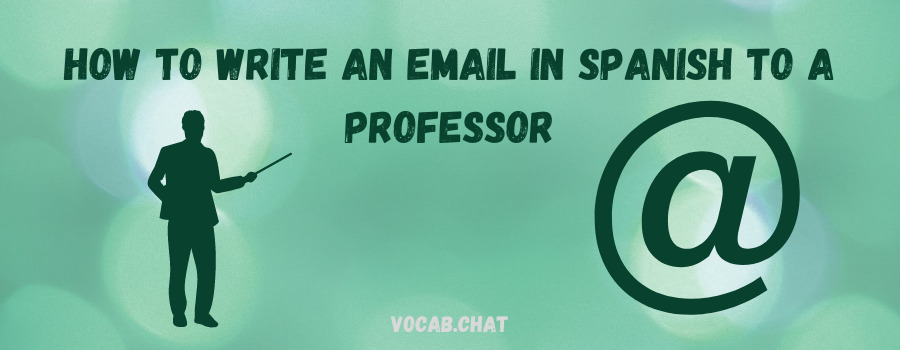How to Write an Email in Spanish to a Professor
So you’re studying abroad in Spanish and you want to email a professor but you don’t want to sound rude. It’s comprehensible. Emails and letters can be much colder than real-life communication due to the lack of facial expressions and body language.
This is why emojis were created in the first place. But as you already know, you can’t use emojis when emailing an authority figure.

So how do you email a professor in Spanish?
The right level of formality in a Spanish email to a Professor
First, you need to know that the language style in your email will depend on how close your relationship with the professor is.
If you’ve known him or her for a long time and you have a certain familiarity with him/her (what we’d call «confianza» in Spanish), you can treat them more informally.
Not as informally as you’d treat a friend —your professor is still an authority figure— but neither as formal as you’d treat the CEO of a company or someone that you’ve never met before.
In other words, you might be allowed to address your professor as «tú» (something that Spanish speakers refer to as «tutear»), but you still don’t want to use slang when talking to him or her.
If you’ve barely talked in person to this professor other than to ask him/her questions about the course, or if they act distant to you like they don’t want to be “friends”, it’s better to be more formal with them.
They’re telling you with their attitude that that’s how they want to be approached, and you should respect that. This is more common in older people, but still, you should never choose your level of formality based on the professor’s age only.
When in doubt, simply go for the formal way as it’s the “safest” thing to do. Your professor will surely let you know if he or she would rather be addressed as «tú». To do this, he or she will most likely employ the imperative form of the verb «tutear», which is «tutéame».
How to start an email in Spanish to a Professor
There are different ways of starting an email in Spanish. Again, it depends on the level of formality.
Most informal email openings are greetings like «hola» (“hello”) and «buenos días» or «buenas tardes» (“good morning” / “good afternoon”).
For example, if you have a close relationship with your professor, you could say «hola, profesor» (“hello, professor”). Optionally, you could add their last name to the phrase: «hola, profesor Sánchez» (“hello, professor Sánchez”).
Some professors will even be okay with being called directly by their first names, but this is something to be wary of —not everyone will like that and it’s better to pass off as too serious than as impolite. Again, your professor will most likely let you know if you can address him or her by their first name.
So what are the “serious” introductions for an email in Spanish? The most common formal email and letter opening is «Estimado/a Sr./Sra [last name]». In this case, it’d be «Estimado/a profesor/a Sánchez» (“dear professor Sánchez”).
You use «estimado» or «estimada», as well as «profesor» or «profesora», depending on the receiver’s gender.
«Querido/a» can also be translated as “dear” but it’s more informal and implies a level of affection. Because of it, it’s mostly used when writing emails or letters for friends, family members, and romantic partners. (on that topic, see: writing a love letter in Spanish)
This is why using «Querido/a» doesn’t sound utterly appropriate in an email to a professor —no matter what the dictionary of synonyms says.
Writing the body of your email
Now that you have properly greeted your professor, you can remind him or her who you are by saying «Mi nombre es [your name and surname]» (“My name is…”). If the professor has several courses, you can add «del curso de…» (“from the…course”).
Normally, professors do teach several courses at once and have too many students to remember them all. They may not identify you solely by name and last name so your professor will surely be grateful if you’re more specific about where you know him or her from.
So the first phrase of your email could be something like one of the following:
“Mi nombre es John Smith del curso de álgebra II”
(My name is John Smith from the algebra II course)
“Mi nombre es John Smith y estoy en el curso de álgebra II”
(My name is John Smith and I’m in the algebra II course) .
You might even want to add where you’re taking that course, especially if this is the first time that you’re emailing the professor and you’re not writing to his or her institutional email for some reason.
“Mi nombre es John Smith y estoy en el curso de álgebra II en la Universidad Nacional Autónoma de México” (My name is John Smith and I’m on the algebra course at the National Autonomous University of Mexico).
After that, you should explain to your Professor the reason why you’re contacting them. To do this, you can use one the following phrases:
“Me dirijo a usted para solicitar…”
(“I’m approaching you to ask you for…”).
“Le contacto para pedirle…”.
“(I’m contacting you to ask you for…”)
“Te molesto para pedirte…”
(“I’m bothering you to ask you for…”).
This one uses the verb “molestar” (bother, disturb, annoy) in a humble way, just like when you say “sorry to bother you” in English.
“Quisiera saber si…”
(I would like to know if…”).
Be aware of the level of formality that you’re using and try to stick to it throughout the whole email. Remember that verbs are conjugated differently depending on the personal pronouns, and «tú» and «usted» are different pronouns, even though they both mean “you”.
| You… | Tú… | Usted… |
| … can (present) |
Puedes | Puede |
| … sent (past) |
Enviaste | Envió |
| …will teach (future) |
Enseñarás | Enseñará |
If you’re using «tú», then also use «te» and «tu» (“your”). If you’re using «usted», use «le» and «su» (formal “your”).
Email closing lines in Spanish
Now that you’ve told your professor everything you wanted to, it’s time to end your email.
You can say that you’ll be waiting for his or her reply with the phrase:
“Espero tu/su respuesta”
(“I await your reply”).
Apart from this, the words “gracias” (“thank you”) and “gracias de antemano” (“thank you in advance”) are very helpful because they fit nearly every email in which you ask a question or a favor.
Then, there are several finishing sentences that you can use depending on the level of formality of the email.
If you’re being informal, you can simply say “un saludo” or “saludos” (which translates as “cheers”). These words go at the end of your email, right before you sign it (if you do).
There are many other informal email closings, but most of them are too affectionate to be used in the context of an email to a professor.
If you’re being formal, you can end your email with “saludos cordiales” (Spanish for “best regards”) or “atentamente” (equivalent to English “sincerely”) or “le saluda atentamente/cordialmente” (“greeting you attentively/sincerely/cordially, [signature]”).
“Atentamente” is often abbreviated as “Atte.” in Spanish, and it’s acceptable to use the abbreviation provided that you’re only using it at the end of your email:
“Atte.,John Smith.”
Forgot something? You can add a postscript. Postscript in Spanish is called “postdata”, which is why it’s abbreviated “P.D.” instead of “P.S.”.
ConclusionThis was a guide to writing an email in Spanish to a professor. We have also published a more general guide on writing emails in Spanish.
